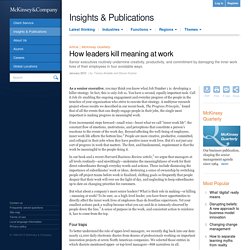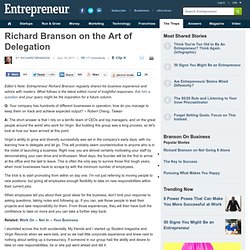

Three Types of People to Fire Immediately. “I wanted a happy culture.

So I fired all the unhappy people.” —A very successful CEO (who asked not to be named) We (your authors) teach our children to work hard and never, ever give up. We teach them to be grateful, to be full of wonder, to expect good things to happen, and to search for literal and figurative treasure on every beach, in every room, and in every person. But some day, when the treasure hunt is over, we’ll also teach them to fire people. Show of hands: How many of you out there in Innovationland have gotten the “what took you so long?” We imagine a whole bunch of hands.
How leaders kill meaning at work - McKinsey Quarterly - Organization - Strategic Organization. As a senior executive, you may think you know what Job Number 1 is: developing a killer strategy.

In fact, this is only Job 1a. You have a second, equally important task. Call it Job 1b: enabling the ongoing engagement and everyday progress of the people in the trenches of your organization who strive to execute that strategy. A multiyear research project whose results we described in our recent book, The Progress Principle, found that of all the events that can deeply engage people in their jobs, the single most important is making progress in meaningful work. Even incremental steps forward—small wins—boost what we call “inner work life”: the constant flow of emotions, motivations, and perceptions that constitute a person’s reactions to the events of the work day. In our book and a recent Harvard Business Review article, we argue that managers at all levels routinely—and unwittingly—undermine the meaningfulness of work for their direct subordinates through everyday words and actions. Simon Sinek: How great leaders inspire action.
Management & Team. Seven Ways to Boost Employee Morale. Richard Branson on the Art of Delegation. Editor's Note: Entrepreneur Richard Branson regularly shares his business experience and advice with readers.

What follows is the latest edited round of insightful responses. Ask him a question and your query might be the inspiration for a future column. Q: Your company has hundreds of different businesses in operation; how do you manage to keep them on track and achieve expected output? ~ Robert Cheng, Taiwan A: The short answer is that I rely on a terrific team of CEOs and top managers, and on the great people around the world who work for Virgin. Virgin's ability to grow and diversify successfully was set in the company's early days, with my learning how to delegate and let go. The trick is to start promoting from within on day one. When employees tell you about their good ideas for the business, don't limit your response to asking questions, taking notes and following up.
Manage the whole head-hunting process with RecruitLoop - TNW Apps. RecruitLoop is an Australian startup with an app in beta that allows you to manage the whole recruiting process online. RecruitLoop allows businesses to post the details of roles they need to fill, which kicks off the first step of the process — selecting a recruiter. Interested recruiters will respond and you’ll be able to compare their experience and feedback to choose the one most suited to your needs. One of the draws of the system for businesses is that recruiters are verified and handpicked by those behind RecruitLoop. Budding recruiters might not be such a big fan of this system, but it keeps the quality high and the noise low. Your recruiter will get started looking for candidates and you’ll receive a shortlist of profiles.
Les cinq principes du Dr House pour manager son équipe. Au détour d’une série, la télévision apporte parfois des réponses pertinentes et synthétiques.

Ainsi le célèbre Docteur House présente une méthode en cinq points pour réussir ses diagnostics. En effet, comment procède-t-il pour résoudre les cas impossibles qui lui sont à chaque fois présentés ? 1. Le Miroir Management, un outil pour matérialiser les décalages à l'intérieur de l'entreprise. Réussir le management stratégique. Management et démarche stratégique Il faut bien le constater, bon nombre d'entreprises ne sont pas particulièrement séduites par la démarche stratégique.

. - Concevoir et mettre en action une stratégie compétitive mûrie et validée ? - Bof bof. C'est pas pour nous tout ça. - Vous savez, nous, on fonctionne encore comme une petite boîte. Les trois freins à un travail de cohésion d’équipe. 1.

L’absence de visibilité Comment faire un diagnostic fiable et scientifique de l’état de l’équipe, de l’impact du management, des besoins individuels et collectifs ? Quelles solutions concrètes apporter et quels indicateurs de résultat sur des sujets tel que la responsabilité, la confiance, le sens, la motivation, l’ambiance, la relation, l’implication, la reconnaissance, la coopération ?
Ces dimensions-là ne rentrent pas dans les schémas classiques de la culture d’Entreprise. Question : Comment changer de paradigme et accepter d’introduire le complexe, le non-mesurable dans l’Entreprise, et peut-être « l’essentiel » ? 2. La pression sur les résultats court terme fait que ce travail de cohésion d’équipe n’est pas prioritaire.